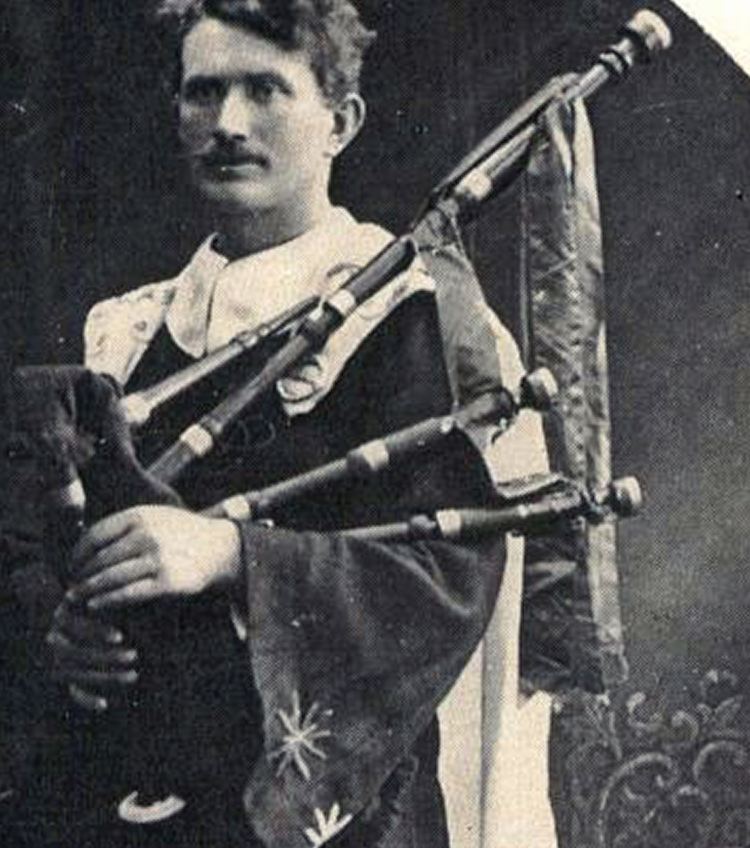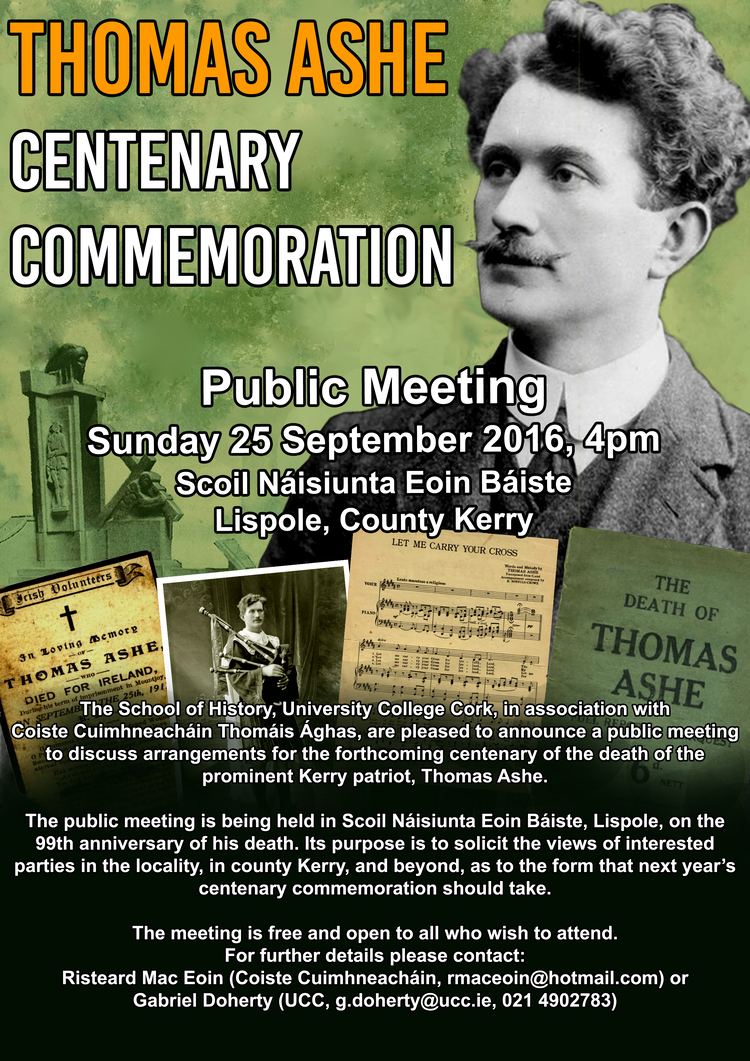Years of service 1913–1917 Name Thomas Ashe | Rank Battalion Commander | |
 | ||
Died September 25, 1917, Dublin, Republic of Ireland Allegiance Irish Republican Brotherhood, Irish Volunteers | ||
Funeral of thomas ashe
Thomas Patrick Ashe (Irish: Tomás Pádraig Ághas; 12 January 1885 – 25 September 1917) was a member of the Gaelic League, the Irish Republican Brotherhood (IRB) and a founding member of the Irish Volunteers.
Contents
- Funeral of thomas ashe
- INQUEST INTO THE DEATH OF THOMAS ASHE
- Background
- Prior to the rising
- The Easter Rising
- Death and legacy
- References

INQUEST INTO THE DEATH OF THOMAS ASHE
Background

Thomas Ashe was born in the townland of Kinard East, Lispole, Dingle, County Kerry, Ireland, to Gregory Ashe (d. 1927), a farmer, and his wife Ellen Hanifin, on 12 January 1885, according to his baptismal record and his sister Nora, or 15 March 1885, according to state birth records. His was a family of ten, seven boys and three girls. Thomas was the seventh child, with three brothers following him. His mother died aged 58, some years before Thomas died. Both Irish and English were spoken in their house, with Thomas's father being a great Irish Scholar and learners of Irish used to come to listen to his stories. Both Irish and English was spoken in the Ashe household.

Having entered De La Salle Training College, Waterford, in 1905 he began his teaching career as principal of Corduff National School, Lusk, County Dublin, in 1908. He taught Irish in Corduff school. He was fond of the Irish language and started branches of the Gaelic League in Skerries and other neighbouring villages. According to his sister Nora he would get the children to march over a union jack.

He spent his last years before his death teaching children in Lusk, where he founded the award-winning Lusk Black Raven Pipe Band as well as Round Towers Lusk Gaelic Athletic Association (GAA) club in 1906.
Prior to the rising

Ashe joined the Irish Volunteers upon its foundation in November 1913. He was a member of the Keating Branch of the Gaelic League. He was a member of the Lusk company of the volunteers and probably founded it. He sat on the governing body of the Gaelic League and collected considerable sums of money during a trip to the USA in 1914 for both the Volunteers and the League.
The Easter Rising

Commanding the Fingal battalion (5th battalion) of the Irish Volunteers, Ashe took a major part in the 1916 Easter Rising outside the capital city. Ashe was commandant of 5th battalion of the Dublin brigade; a force of 60–70 men engaged British forces around north County Dublin during the rising. Ashe was sent a messenger Mollie Adrian by Pearse with orders to hold the main road from Fairyhouse. She was sent back to report to Connolly, who returned an order to send 40 men to the GPO. Ashe was only able to send 20 due to his shortage of men.

He was to contact 1st battalion at Cross Guns Bridge, although he found no one there because vice-commandant Piaras Beaslai knew nothing of this plan. The area was dominated by the central feature of Broadstone station, at the end of the line to Athlone, an important British army barracks. But for some reason they decided not to occupy and garrison the station; similarly the Citizens Army had been confusingly required to withdraw from Mallin. The lack of co-operative communication was later discussed in Piaras Beaslai's books, the research for which included taking accounts from Thomas Ashe whilst they were incarcerated. The failure of inexperienced volunteers to properly co-ordinate their deployments was a critical factor at defeat. Ashe himself had only been appointed commandant shortly before Easter. They were armed only with a few rounds, about a dozen service rifles, a dozen Mausers, and a dozen Martini carbines; some had only a shotgun against well-equipped army regulars.
The battalion won a major victory in Ashbourne, County Meath where they engaged a much larger force capturing a significant quantity of arms and up to 20 Royal Irish Constabulary (RIC) vehicles. Eleven RIC members, including County Inspector Alexander Gray, and two volunteers were killed during the five-and-a-half-hour battle. Twenty-four hours after the rising collapsed, Ashe's battalion surrendered on the orders of Patrick Pearse.
When he received the order to surrender he had his doubts as he had difficulty believing the rebels in Dublin had not had success as he did. He sent Richard Mulcahy to Dublin to verify its authenticity.
On 8 May 1916, Ashe and Éamon de Valera were court-martialled and both were sentenced to death. The sentences were commuted to penal servitude for life. Ashe was imprisoned in Frongoch Internment camp and Lewes Prison in England. While in prison he wrote the poem “Let Me Carry Your Cross for Ireland, Lord”.
With the entry of the US into World War I in April 1917, the British government was put under more pressure to solve the 'Irish problem'. De Valera, Ashe and Thomas Hunter led a prisoner hunger strike on 28 May 1917 to add to this pressure. With accounts of prison mistreatment appearing in the Irish press and mounting protests in Ireland, Ashe and the remaining prisoners were freed on 18 June 1917 by Lloyd George as part of a general amnesty.
Death and legacy
Thomas Ashe was released from jail in June 1917 under the general amnesty which was given to republican prisoners. Upon release, Ashe returned to Ireland and began a series of speaking engagements. In August 1917, Ashe was arrested and charged with sedition for a speech that he made in Ballinalee, County Longford where Michael Collins had also been speaking. He went on the run but was captured in Dublin and detained at the Curragh but was then transferred to Mountjoy Prison in Dublin.
He was convicted and sentenced to two years hard labour. Ashe and other prisoners, including other Kerrymen Fionán Lynch and Austin Stack, demanded prisoner of war status. As this protest evolved Ashe again went on hunger strike on 20 September 1917. As this was a breach of prison discipline the authorities retaliated by taking away the prisoners' beds, bedding and boots. After five or six days lying on a cold stone floor the prisoners were subjected to forcible feeding. On 25 September, Fionan Lynch saw Ashe being carried away to receive this treatment and called out to him: ' Stick it Tom boy'. Ashe called back 'I'll stick it, Fin'. That was the last time they spoke to each other. Ashe was carried back, blue in the face and unconscious. He was removed to the Mater Misericordiae Hospital (which actually faces the prison) where he died within a few hours. "Tom Ashe's body lay in state in the hospital morgue, dressed in his Volunteer Republican uniform, and 30,000 mourners filed by.
At the inquest into his death, the jury condemned the staff at the prison for the "inhuman and dangerous operation performed on the prisoner, and other acts of unfeeling and barbaric conduct".
The death of Thomas Ashe and the subsequent funeral procession had a striking effect on the attitude of the Irish people and became a rallying call to the standard of the Irish Republic. Though not on the scale of O'Donovan Rossa's funeral two years previous, the military aspect of the funeral proved that the Irish Volunteers were well on their way to being restored to pre-1916 levels. Thomas Ashe's remains lay in state in Dublin's City Hall before a funeral procession of over 30,000 marched to Glasnevin Cemetery on 30 September 1917. Michael Collins delivered the funeral eulogy in Irish and English, following the firing of a volley by uniformed Irish Volunteers. The English eulogy being " nothing additional remains to be said. That volley which we have just heard is the only speech which is proper to make above the grave of a dead Fenian".
He was related to American actor Gregory Peck.
